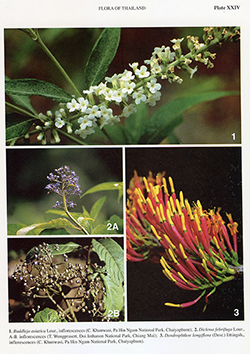e-Flora of Thailand
Volume 7 > Part 4 > Year 2002 > Page 656 > Buddljaceae > Buddleja
Buddleja asiatica Lour.wfo-0000573923
Fl. Cochinch.: 72. 1790; Benth. in DC., Prodr. 10: 446. 1846; C.B.Clarke in Hook.f., Fl. Brit. Ind. 4: 82. 1883; Gagnep., Not. Syst. 2: 189–190. 1912; Marquand, Bull. Misc. Inform. Kew 1930: 177. 1930; Kerr in Craib & Kerr, Fl. Siam Enum. 3(1): 53. 1951; Leenh. in Fl. Mal. I, 6: 337, f. 24. 1963; Leeuwenb., G.Vidal, Galibert, Fl. C.L.V. 13: 92–93, f. 15, 1–8. 1972; Leeuwenb., The Loganiaceae of Africa XVIII. Buddleja L. 11. 92–96, f. 22. 1979; P.H.Hô, Câyco Viêtnam 2: 1109. 1993. Fig. 1; Plate XXIV: 1.
Accepted Name : This is currently accepted.
Synonyms & Citations :
Description : Shrubs 1–5 m high; most parts with stellate hairs. Branchlets more or less terete. Leaves remotely to very serrate, 2.5–16 x 0.6–3.6 cm; petiole ± sessile to ca 80 mm; upper surface, sometimes pubescent, tip acuminate, base cuneate or decurrent or winged, stipules reduced to a line. Inflorescence terminal and or axillary, thyrsoid to spiciform, ca 1.5–31 x 0.5–2 cm, cymes sometimes subtended by a narrowly linear to lanceolate bract 1.5–5 x ca 0.5 mm, sometimes sparsely scaly, and sometimes exceeding length of cymes. Calyx campanulate, entire, 2–3.5 x 1–2.25 mm, inside usually glabrous, sometimes puberulent, teeth 1–1.75 x 0.5–1 mm, narrowly triangular to triangular, apex acuminate, occasionally puberulent with scattered groups of scales, margins sometimes glabrous or puberulent, somtimes with a linear-lanceolate bracteole 1.5–2.25 mm long. Corolla: lobe margins and inside usually glabrous, white, (yellowish-brown and dark red has been recorded); tube 3–6 x 1–1.5 mm; mouth sometimes slightly constricted, with a broad ring of dense usually pilose hairs extending to top of stamens, hairs less dense towards base of tube; lobes 0.75–1.75 x 0.05–1.5 mm, campanulate usually orbicular, sometimes crenate. Stamens clavate, deeply cordate at base, included, top of anthers about level with mouth, 0.5–1 mm; filament ± sessile–0.75 mm, usually about half length of anther. Ovary usually glabrous; conical, pyriform to ovoid, gradually tapering or abruptly narrowed into style, bottom of ovary often with irregular saccate ring; stigma clavate, usually glabrous; pistil 1.75–3.5 mm; ovary 1–1.75 x 0.5–0.75 0.3–0.7 mm, stigma 0.5–0.75 mm; style ca 0.25–1 mm. Capsule conical, 3–4.5 x 1.25–2.25 0.5–1.75 mm. Seeds reticulate, ellipsoid to irregular, 0.5–1 x 0.2–0.35 mm.
Thailand : NORTHERN: Mae Hong Son, Chiang Mai, Chiang Rai, Lampang, Phrae, Sukhothai; NORTH-EASTERN: Loei; EASTERN: Chaiyaphum, Ubon Ratchathani; SOUTH-WESTERN: Kanchanaburi, Phetchaburi; PENINSULAR: Phangnga, Phuket, Trang.
Distribution : India, Nepal, Bangladesh, Burma, Laos, Cambodia, Vietnam (type), Malaysia, Indonesia, New Guinea, the Philippines, China, Hong Kong, Taiwan.
Ecology : Cleared areas at edges of forests, along riversides and streams, scattered in old clearings and in secondary grassy vegetation, 300–2,550 m alt.
Vernacular : Phu-chi-boi (พู่จี่บอย)(Karen-Mae Hong Son); rachawadi pa (ราชาวดีป่า) hua thuean (หัวเถื่อน), puak nam (ปวกน้ำ)(Chiang Mai); nguang chang (งวงช้าง)(Chaiyaphum); mae mai (แม่ม่าย)(Kanchanaburi); dok thon (ดอกถ่อน), fon (ฟอน)(Loei).
Uses: Root used in decoction as part of mixed drug, against stones in the urinary tract, crushed leaves applied to burns.


